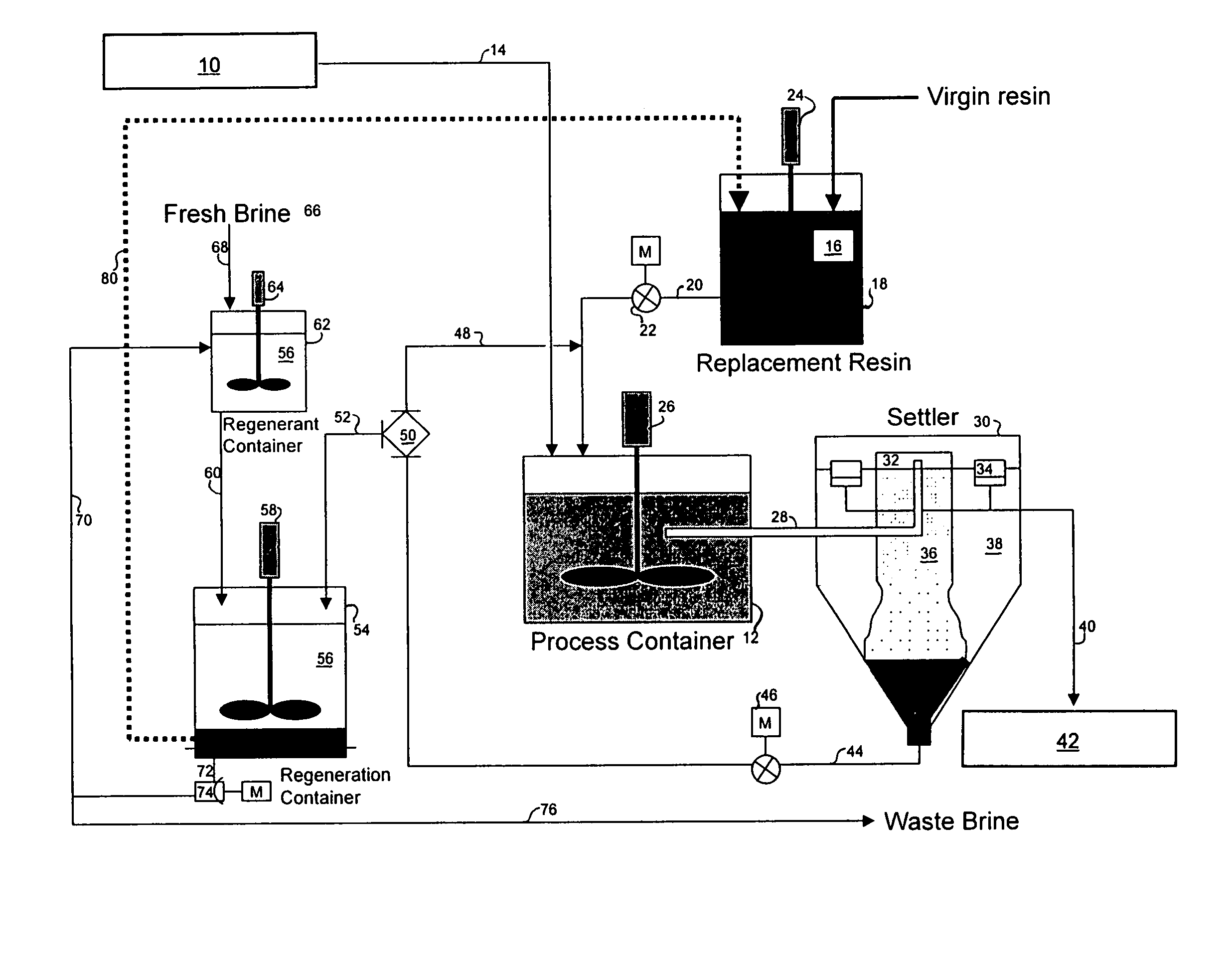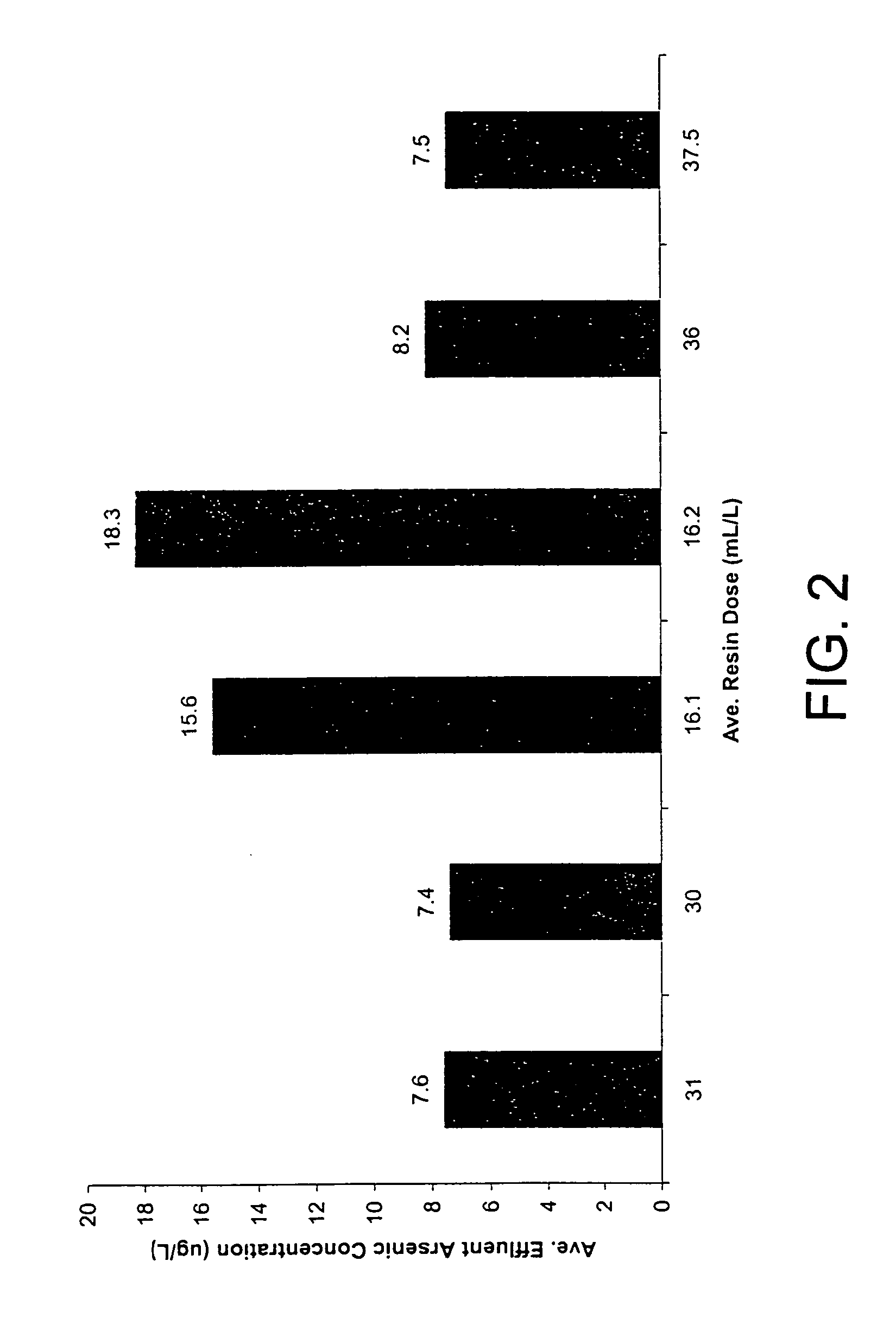Inorganic contaminant removal from water
a technology of inorganic ionic species and water supply, applied in the direction of water/sludge/sewage treatment, specific water treatment objectives, solid sorbent liquid separation, etc., can solve the problem of significant risk of breakthrough and chromatographic peaking events, and the method of using such particulate ion exchange resins is not disclosed
- Summary
- Abstract
- Description
- Claims
- Application Information
AI Technical Summary
Benefits of technology
Problems solved by technology
Method used
Image
Examples
example 1
Arsenic V Trial
[0095]A trial was undertaken to assess arsenic removal from a water under continuous flow conditions of raw water containing a stable influent arsenic level in the range of 49.9 to 54.2 μ / L arsenic, predominantly as arsenic V, with a silica background in the water of around 100 to 110 μg / L and a sulfate background of about 12 to 15 mg / L. The water processing facility in which the test was conducted uses ground water having a daily capacity of 4 million gallons per day (MGD). It currently does not apply any form of pre-treatment before delivering water to the distribution system. New contaminant guidelines require a maximum of 10 μg / L total arsenic for drinking water.
[0096]A three-week trial was undertaken to demonstrate the ability of the magnetic resin process of this invention to remove arsenic from the ground water supply down to a level of 10 μg / L or less. The trial was conducted using a two-gallon-per-minute (2 GPM) pilot plant set-up similar to that shown in FIG...
example 2
Perchlorate Removal from Surface Water
[0106]Influent water in this trial was drawn directly from a surface water source. The trial was conducted using a 10 GPM magnetic resin pilot plant similar to that shown in FIG. 1. The water contained perchlorate in quantities ranging from 2.5 to 3.6 μg / L.
[0107]Resin dose was varied between 20 and 50 mL / L. Contact time and regeneration rate were held constant for the majority of the trial at 30 minutes and 10% respectively.
[0108]The capability of the magnetic resin process to remove perchlorate from this water was demonstrated. Results showed that removal efficiencies of 50% are achievable under the operating conditions applied during this trial; and perchlorate removal efficiency increases with increasing resin dose.
[0109]There was a high level of background sulfate in the water, typically in excess of 200 mg / L.
[0110]Removal efficiencies do not stabilize until the process has been running for some time. In this pilot plant setting, the entire ...
example 3
Chromium (VI) Trial
[0127]The groundwater tested was from wells that typically contain less than 10 μg / L total chromium. Water for this trial was spiked with 100 μg / L chromium (VI). The magnetic resin process was trialed using a 2 GPM pilot plant over a three week period. Flow rates varied from 0.5-1 GPM. Resin doses were varied between 10 and 60 mL / L, contact times between 15 and 40 minutes, and regeneration rates between 6% and 18%.
[0128]The magnetic resin trial can be divided into three sections (see FIGS. 5 to 7). For Samples 1 through 21, the resin dose was varied between 10 and 32 mL / L, the contact time between 15 and 40 minutes and the regeneration rate between 6% and 18%. In this period, the effectiveness of the magnetic resin process was variable, removing between 50% and 88% Cr (VI). For Samples 22 through 26, constant conditions of 40 mL / L resin dose, 35 min. contact time and 16% regeneration rate were applied. In this region, removal was consistently above 88% with an ave...
PUM
| Property | Measurement | Unit |
|---|---|---|
| concentration | aaaaa | aaaaa |
| concentration | aaaaa | aaaaa |
| concentration | aaaaa | aaaaa |
Abstract
Description
Claims
Application Information
 Login to View More
Login to View More - R&D
- Intellectual Property
- Life Sciences
- Materials
- Tech Scout
- Unparalleled Data Quality
- Higher Quality Content
- 60% Fewer Hallucinations
Browse by: Latest US Patents, China's latest patents, Technical Efficacy Thesaurus, Application Domain, Technology Topic, Popular Technical Reports.
© 2025 PatSnap. All rights reserved.Legal|Privacy policy|Modern Slavery Act Transparency Statement|Sitemap|About US| Contact US: help@patsnap.com



